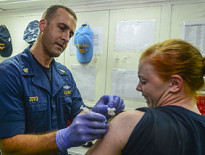
Credit: CDC/Dr. Mike Miller
If you’re over 65, there’s a new vaccine you should know about.
But before I explain the vaccine, let me introduce you to the bacterium that the vaccine protects you from. The little blue ovals in the above picture are Streptococcus pneumoniae bacteria. You might have guessed by its name that S. pneumoniae is a leading cause of pneumonia, and you’d be right. Pneumonia is an infection of the lungs, usually manifested by fever, productive cough, and shortness of breath. Pneumonia can be caused by bacteria, viruses, and fungi, but S. pneumoniae is such a common cause of pneumonia that it’s nicknamed the pneumococcus – the coccus (little round bacterium) that causes pneumonia.
The Centers for Disease Control and Prevention (CDC) estimate that 900,000 people in the U.S. contract pneumococcal pneumonia every year, and tens of thousands of them die. Pneumonia is usually treated with antibiotics, but some strains of the pneumococcus have developed resistance to some drugs. If that wasn’t bad enough, S. pneumoniae can also cause bloodstream infections and meningitis, which are even more life-threatening than pneumonia.
Given the severity of pneumococcal illness in people over 65, prevention in this age group has been critical. For over 30 years a pneumococcal vaccine called Pneumovax 23 has been recommended for everyone 65 and over. (The generic name for Pneumovax 23 is PPSV23, 23-valent pneumococcal polysaccharide vaccine. You don’t need to know that for the test. I’m just mentioning it here because you’ll see that name in other articles. Oh, and there is no test.) Pneumovax 23 protects against 23 different strains of S. pneumoniae but the immune response it stimulates in patients is just meh. That’s good enough to protect against bloodstream infections and meningitis, so it still saves many lives, but the evidence that it prevents pneumonia isn’t very strong.
A newer vaccine against the pneumococcus appeared in 2010. It’s called Prevnar 13 (PCV13, 13-valent pneumococcal conjugate vaccine). It has been used since that time in vaccinating children. It only covers 13 strains of pneumococcus but it stimulates a much stronger immune response than Pneumovax 23. Interestingly, there is some evidence that immunizing children against the pneumococcus has led to fewer pneumococcal illnesses in older people since there are fewer sick kids around to infect them. This is another bit of evidence of a phenomenon called herd immunity – immunizing some members of a “herd” protects the rest of them just because there are fewer vulnerable members to transmit the disease.
Recently Prevnar has been tested in and approved for use in seniors. A recent study showed definitively that it helps protect from bloodstream infections, meningitis, and pneumonia caused by the pneumococcus. Last month the CDC recommended Prevnar in everyone 65 and older.
Because Pneumovax 23 covers more strains, seniors should now receive both vaccines, not just the new one, but because the two vaccines protect against some of the same strains, they can’t be given at the same time. Here’s the recommended timing.
- People 65 and over who haven’t received either vaccine should first receive Prevnar 13 followed 6 to 12 months later by Pneumovax 23.
- People 65 and over who have already received Pneumovax 23 since they turned 65 should receive Prevnar 13 at least a year after receiving Pneumovax 23.
- People 65 and over who have already received Pneumovax 23 before turning 65 should receive Prevnar 13 at least a year after their most recent Pneumovax dose, and then should receive another dose of Pneumovax 6 to 12 months after the Prevnar but not earlier than 5 years after the last Pneumovax dose.
Got that? If not, this handy box illustrates the options nicely. The good news is that you can get the flu vaccine at the same time as either pneumococcal vaccine, so you’ve got that going for you, which is nice.
So if you’re 65 or older make sure that you get both Pneumovax and Prevnar in whichever order is appropriate for you. And if you’re younger, make sure your parents and aunts and uncles get the news. Because you don’t want the above picture to be the blood culture of someone you love.
Learn more:
Some Good News on Pneumonia (New York Times, The New Old Age blog)
New Advice for Vaccines to Stave Off Pneumonia (Wall Street Journal)
Pneumococcal Vaccination (Centers for Disease Control and Prevention)
Use of 13-Valent Pneumococcal Conjugate Vaccine and 23-Valent Pneumococcal Polysaccharide Vaccine Among Adults Aged ≥65 Years: Recommendations of the Advisory Committee on Immunization Practices (ACIP) (Morbidity and Mortality Weekly Report)

